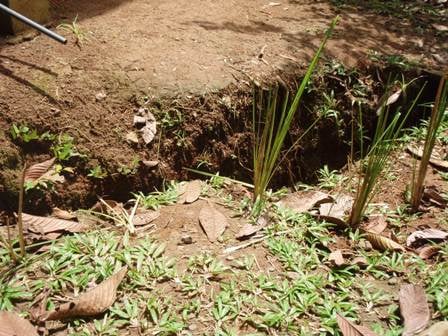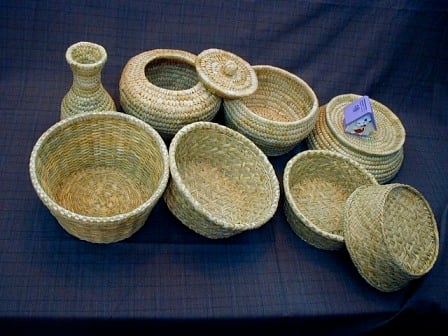Background
Vetiver (Chrysopogon zizanioides) is a perennial grass, native to India (known as Khus in India). Because of its deep sturdy roots and non invasive growth habit Vetiver is an ideal plant for applications for erosion control and water mitigation. In most developing countries many of the Vetiver can be applied at minimum cost to poor rural communities to enhance quality of life through protection of water supplies, improving soils and increasing farm benefits, cleaning up waste water and reduction of diseases, protection of rural infrastructure, and providing byproducts for handicrafts, forage, mulch, thatch, medicines, and Vetiver plant material for sale to other users.
The Vetiver Network International has developed The Vetiver System, a concept integrating simple scientific principals of hydrology, soil mechanics, and similar natural processes to manage soil and water on a landscape scale. They have implemented this system in many locations internationally and are an excellent resource.
Growth
Vetiver grass(Chrysopogon zizanioides) grass grows in a clumps and can reach 1.5 m in height. Unlike most grasses which form horizontally spreading mat-like root systems, Vetiver’s roots grow downward up to 2-4 meters in depth. Vetiver is a self-riser, meaning that as silt builds up around the base of the grass clump the crown rises to match the new soil level.
There are two varieties of vetiver, a wild type with colonizing root system (invasive) and the domesticated variety. The domesticated variety is not considered especially invasive as it's via above ground asexual clones.
Vetiver does best if it is established in full sun and then it can survive in deep shade for decades, tolerating near darkness found under canopy of tropical forests and rubber tree plantations.
Potential Uses/Benefits
Agricultural improvement
uses for: soil and water conservation, soil moisture improvement, groundwater recharge, recycling soil nutrients, pest control, mulch, forage, clean up of agricultural contaminated waste water, protection of farm infrastructure (canals, drains, roads, and building sites).
Disaster mitigation
can be used to reduce potential disasters caused by extreme rainfall events. Stabilization of levees and sea dikes reduces the chance of breaching and subsequent devastating flooding. Steep slope protection by Vetiver grass reduces potential land slippage caused by high rainfall events.
Landscaping
can be applied for urban landscaping including beautification, slope stabilization, traffic dividers, demarcation of walkways, prevention of urban erosion etc.
Prevention and Treatment of Contaminated Waste land
Vetiver grass will tolerate high levels of nitrates, phosphates, heavy metals, and agricultural chemicals. The Vetiver System can be used for treating wastewater, rehabilitating mine tailings, stabilizing landfills and general rubbish dumps. Vetiver takes up the toxic materials and confines the contaminates to the effected area.
Soil Erosion Control
Narrow hedgerows of Vetiver grass will spread out rainfall runoff across the slope, act as a filter to trap erosion sediment, create natural terraces and reduces the velocity of rainfall runoff. It has application for on farm soil and water conservation, rehabilitation of eroded lands, and prevention of erosion on sloping lands. The roots have been used in stabilizing earthen structures such as berms, stream banks, terraces, and rice paddies..
Slope Protection
The combination of deep roots with tensile strength of 75 MPa that improve the shear strength of soil by as much as 40% makes Vetiver grass an ideal plant for stabilizing steep and unstable slopes. The Vetiver System when applied to such slopes significantly reduces the probability of land slippage and reduces the need for “hard solutions”. Applications include highway, railway, riverbanks, public utility right of ways, canal, dikes, and levee slope
Handicrafts and NTFPs
Vetiver grass is a potential non-timber forest product (NTPF), providing a source of excellent material for handicrafts, particularly if the leaves are properly processed first. Vetiver is also made into perfumes and used medicinally.
Vetiver root can be woven into baskets, with a strong and pleasant fragrance similar to sandalwood.
Resources
For more information:
- Vetiver Systems Application - A Technical Reference Manual: Second Edition. June 2008. by Paul Truong, Tran Tan Van, and Elise Pinner


